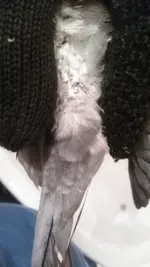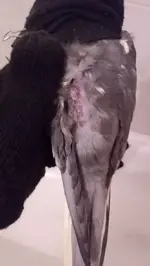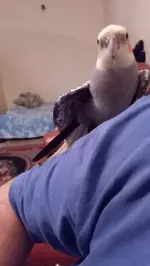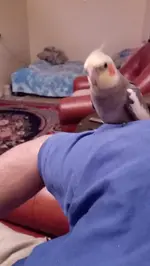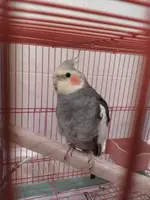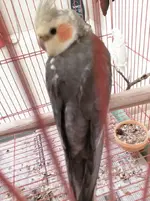I think that Lamanku comment about the preen gland had merit. It does look like something's is up with the gland. Some research shows that low vitamin A can play a role. Low vitamin A is a big problem with parrots on an all seed diet. So definitely get him eating veggies high in vitamin A
The uropygial area is located dorsally over the pygostyle, on the midline, at the base of the tail. Secretions of this gland are an important component in maintaining feathers' condition.
Synonyms
Preen gland, oil gland
Epidemiology
Species, Age, Sex
All species that have a uropygial gland and all ages and both sexes can be affected by uropygial gland disease presentations.
Genetics and Breed Predisposition
None specific, but certain avian species (e.g., Amazon parrots, hyacinth macaws) do not have a uropygial gland; therefore, they would not be susceptible to disease conditions associated with this gland.
Risk Factors
•
Trauma to uropygial gland
•
Self-mutilation/feather/picking around the gland
•
Impaction of the gland
•
Infectious cause (e.g., bacterial)
•
Glandular or ductular neoplasia
•
Nutritional deficiencies (e.g., vitamin A)
https://www.sciencedirect.com/topics/veterinary-science-and-veterinary-medicine/uropygial-gland
Note : I don't think it looks ruptured or had a tumor or anything like that. But feather picking, stress , and low vitamin A
Inactive, Impacted, Blocked or Ruptured Oil Gland
A well-functioning oil gland will help a bird keep the feathers in good condition, in addition to water proofing and insulating the plumage.
Poor feather quality:
The gland occasionally gets blocked or stops producing some or all of its oil, at which point the feather quality typically deteriorates.
An impacted oil gland is usually clearly visible by the time you notice a difference in feather quality.
Seizures:
An atrophied oil gland can cause seizures. As the oil gland produces vitamin D3 precursors that are spread into the feathers as the birds preen themselves. Upon exposure to ultraviolet light, the precursors will be converted to active D3, which will then be ingested when the birds preen themselves again.
Testing an oil gland ...
Check for Swelling: The first course of action would be to part the feathers over the oil gland and check on the condition of the oil gland. If there is an unusual swelling, this would indicate an impacted oil gland.
Verify Oil Production: Gently roll the gland ("wick") through your fingers, and then check your fingers for greasy spots. If your fingers look and feel very oily, the oil gland is working. If no secretion are seen or felt, gently massage the gland and then check again. If you can only feel a little oil, the oil gland may not be functioning properly or may be completely blocked.
Possible Causes:
Tumor: The preen / oil gland is enlarged and distorted in shape. As a result the small feathers over the gland become raised and the tail feathers tend to fall out and not regrow.
Infection: An oil gland malfunction can be caused by an infection and a vet may prescribe Baytril or another broad-spectrum antibiotic for 7 - 14 days.
Stress can also cause a failing oil duct. This often happens, when captive birds are being picked upon by other birds in their environment. In this case it is best to separate them from the aggressive birds.
Malnutrition can also cause oil gland problems; such as Vitamin A deficiency. A proper diet and potential supplementation should be discussed with the vet. Adding wheat into your bird's diet may also help the gland to recover and produce more oil. To this end, some vets recommend adding SMALL amounts of fish oil to a bird's diet. Too much fish oil can get messy. Some people have added cat kibble with fish oil to their bird's diet instead. ( Not sure about this!)!
Treatment of Ruptured Oil Glands:
Ruptured glands must be surgically removed immediately; following the surgery, the plumage will obviously no longer repel water
Antibiotics need to be administered.
A drain may need to be inserted for a few days
Other potential treatments:
Antibiotics may need to be administered.
An impacted / blocked oil gland might be resolved with the use of hot packs (not too hot to burn the sensitive skin of a bird!). The hot pack should only be "warm". This "hot pack" held gently against the oil gland may help.
Gentle massage to the gland two or three times a day
Reducing stress and improving diet.
Some vets may suggest lancing the gland (releasing pus or pressure built up) Don't think you have to worry about that!!
https://www.beautyofbirds.com/birdoilgland.html
